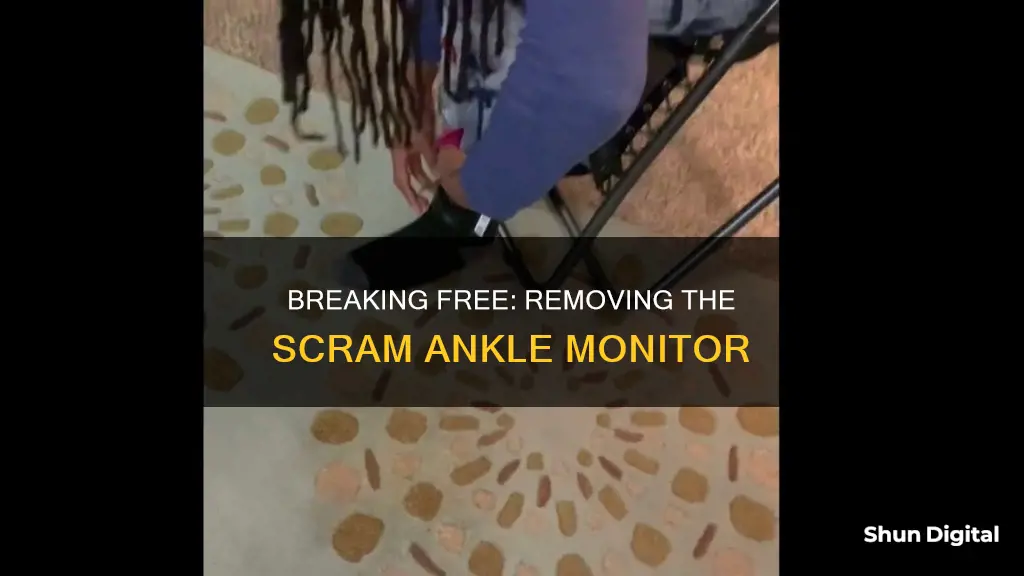
SCRAM ankle monitors are alcohol-monitoring devices that courts order DUI offenders to wear. The acronym SCRAM stands for Secure Continuous Remote Alcohol Monitor. These devices are also known as Continuous Alcohol Monitoring (CAM) bracelets and are designed to test the wearer's perspiration for alcohol every 30 minutes. They are equipped with anti-tampering technology, and removing or attempting to destroy them will result in alerts being sent to the monitoring company, which then reports the tampering to the court or probation department. Offenders may face severe consequences such as termination of probation or jail time if they tamper with their SCRAM bracelet.
| Characteristics | Values |
|---|---|
| What is a SCRAM ankle monitor? | An alcohol detector in the form of an ankle bracelet. |
| Who has to wear it? | DUI offenders, second-time and third-time offenders, parents in family court, domestic violence cases, underage drinking cases, and cases involving charges related to substance abuse. |
| How does it work? | It tests the wearer's perspiration every 30 minutes. |
| How accurate is it? | Generally, courts have decided that SCRAM bracelets are scientifically sound and that evidence of alcohol consumption and tampering are reliable enough to be admitted into court proceedings. |
| How much does it cost? | Installation fee: $50 to $100. Daily monitoring fee: $10 to $15. Monthly cost: up to $300. |
| What happens if you remove it? | If you remove the SCRAM ankle monitor, the regional monitoring center will be alerted immediately. This will result in probation violation and punishment such as harsh sentencing or longer probation. |
| How long do you have to wear it? | The amount of time depends on the facts surrounding your conviction. It could be a month, a year, or even longer. |
What You'll Learn
- Removing a SCRAM ankle monitor will result in an immediate alert being sent to the regional monitoring centre
- Offenders must wear SCRAM ankle monitors 24/7 and cannot remove them until the court-ordered sobriety period is over
- SCRAM ankle monitors test the wearer's sweat every 30 minutes for the presence of alcohol
- The monthly cost of wearing a SCRAM bracelet can run up to $300
- SCRAM bracelets are often equipped with GPS locators and used for people who are on house arrest

Removing a SCRAM ankle monitor will result in an immediate alert being sent to the regional monitoring centre
SCRAM ankle monitors are court-ordered alcohol-monitoring devices worn by DUI offenders and other individuals with alcohol-related issues. These devices are designed to detect alcohol consumption by testing the wearer's perspiration every 30 minutes. They are equipped with advanced technology that can identify any attempts to tamper with or remove the device.
If an individual attempts to remove a SCRAM ankle monitor, an immediate alert will be triggered, and the regional monitoring centre will be notified. This is due to the device's built-in anti-tamper technology, which is designed to detect any attempts to remove or destroy the device. The monitoring company will then report this violation to the court or the probation department.
The consequences of removing a SCRAM ankle monitor can be severe. It is considered a probation violation and can result in harsh sentencing or an extended probation period. In some cases, individuals may even face jail time or other penalties for removing the device. Therefore, it is essential to understand that tampering with or removing a SCRAM ankle monitor can lead to significant legal repercussions.
It is important to note that the SCRAM ankle monitor is court-ordered and mandatory for the specified period. The duration of monitoring depends on the facts surrounding the conviction and the sanctioned period determined by the judge. While wearing the device may be uncomfortable and inconvenient, it is a necessary condition for maintaining compliance and ensuring community safety.
In conclusion, removing a SCRAM ankle monitor will result in an immediate alert and notification to the regional monitoring centre. This can lead to serious legal consequences, including extended probation or even jail time. It is crucial to comply with the court-ordered monitoring period to avoid these repercussions and to demonstrate commitment to sobriety and behavioural change.
Blind Spot Monitor: DIY Installation and Setup Guide
You may want to see also

Offenders must wear SCRAM ankle monitors 24/7 and cannot remove them until the court-ordered sobriety period is over
SCRAM ankle monitors are court-ordered for those who have been convicted of a DUI, especially second-time and third-time offenders. The monitors are an effective way to ensure that offenders abstain from alcohol, as they are alcohol detectors in the form of an ankle bracelet. SCRAM stands for "Secure Continuous Remote Alcohol Monitor", and the devices monitor the wearer's blood alcohol concentration by testing their sweat every thirty minutes. The devices are built by SCRAM Systems, which has a database that analyses alcohol consumption alerts. Once the offender drinks alcohol, an alert is sent to this database, and a trained analyst investigates further to determine if probation officers need to be notified.
The SCRAM ankle monitor is a useful alternative to incarceration, allowing offenders to continue with their daily lives while being monitored. Offenders can go to work, travel, run errands, and socialise with friends and family. However, they must refrain from consuming alcohol. The SCRAM monitor will notify the probation officer if alcohol is consumed, leading to further penalties such as jail time, fines, and prolonged probation.
The SCRAM ankle monitor is to be worn 24/7, and removing it before the court-ordered sobriety period is over is a violation of probation. If an offender attempts to remove or tamper with the device, the regional monitoring centre for SCRAM Systems will be alerted immediately. This can result in harsh sentencing or an extended probation period.
The duration of wearing the SCRAM ankle monitor depends on the facts surrounding the conviction and the judge's decision. While it may be uncomfortable to wear the monitor continuously, it is crucial to comply with the court's orders to avoid further legal consequences. The monitor will be worn for a sanctioned period, typically ranging from a month to a year or longer, depending on the case.
Removing Monitor Back Backdrops: A Step-by-Step Guide
You may want to see also

SCRAM ankle monitors test the wearer's sweat every 30 minutes for the presence of alcohol
SCRAM ankle monitors, or Secure Continuous Remote Alcohol Monitors, are court-ordered devices that people convicted of driving under the influence (DUI) or other alcohol-related offences must wear. They are also used in other types of cases where alcohol use is a concern, such as family court, domestic violence cases, underage drinking cases, and substance abuse cases. These monitors are designed to detect alcohol and any attempts to tamper with the device itself.
The SCRAM CAM bracelet tests the wearer's sweat for alcohol every 30 minutes, 24 hours a day. This is known as "transdermal" testing, which detects alcohol secreted through the skin. When a person consumes alcohol, 95% is metabolized by the liver, 4% is expelled through the lungs and kidneys, and the remaining 1% is eliminated through the skin via sweat. The SCRAM device has a fuel-cell sensor that sits on the skin and measures the concentration of alcohol by taking samples of vapour perspiration at regular intervals.
The device then transmits the readings to a monitoring service provider, which converts the transdermal concentration to a blood alcohol concentration (BAC). If alcohol is detected, the provider notifies the court of the person's BAC reading. This automated testing ensures that clients cannot drink around testing schedules, supporting their sobriety while keeping them accountable.
The cost of a SCRAM bracelet includes an installation fee and a daily monitoring fee. The installation fee typically ranges from $50 to $100, while the daily monitoring fee is usually between $10 and $15, resulting in monthly costs of up to $300 or more. Courts usually require defendants to pay these fees.
Monitoring iPad Usage: Strategies for Parents and Guardians
You may want to see also

The monthly cost of wearing a SCRAM bracelet can run up to $300
SCRAM bracelets, or Secure Continuous Remote Alcohol Monitoring devices, are court-ordered alcohol-monitoring ankle bracelets for people convicted of driving under the influence (DUI) or other cases involving drugs and alcohol. They are also used as a pretrial condition of probation that determines someone's release from jail. The bracelets monitor the wearer's perspiration every 30 minutes to detect the presence of alcohol.
In addition to the financial cost, wearing a SCRAM bracelet can impact your daily life. While you can still work, travel, run errands, and socialise, you must be careful when performing everyday tasks. For example, you should only use alcohol-free soap and water to clean around the bracelet, and only take showers instead of baths to avoid getting the device wet, which could be seen as an attempt to destroy it. You must also notify security personnel at airports when travelling with the device.
It's important to note that attempting to remove or tamper with a SCRAM bracelet is not advisable. These devices are designed to detect any kind of tampering, and if removed, the regional monitoring centre will be alerted immediately, resulting in potential consequences such as harsh sentencing or longer probation.
Choosing the Right Monitor: Size Considerations
You may want to see also

SCRAM bracelets are often equipped with GPS locators and used for people who are on house arrest
SCRAM ankle monitors are alcohol detectors in the form of ankle bracelets. They are often used for DUI offenders to monitor their blood alcohol concentration. The bracelet tests the wearer's sweat every thirty minutes for the presence of alcohol, and this skin-level measurement is known as "transdermal" alcohol concentration. This continuous alcohol monitoring supports long-term behaviour change and complements treatment for alcohol dependence or addiction.
SCRAM bracelets are also equipped with GPS locators and used for people on house arrest. The GPS technology in SCRAM bracelets provides superior location accuracy and long battery life, helping officers quickly identify and address issues in their caseload. For high-risk clients requiring constant location monitoring, SCRAM GPS offers revolutionary tamper technology that virtually eliminates false alerts and provides nearly instant notifications, enabling officers to act quickly.
The GPS location monitoring is a useful alternative to incarceration for community corrections, as it helps officers more effectively supervise clients while enhancing community safety. With Google Maps and Google Info windows built into the SCRAM GPS monitoring software, officers can quickly identify a client's exact location and easily understand their movements.
SCRAM GPS Analytics takes the 1,440 location points a client generates per day and presents it as clean, easy-to-view information. This allows officers to quickly make sense of client movements by reviewing stop patterns, charging, and alert analysis without having to revise data point-by-point. This saves time for both the clients and the officers.
Buying Monitor Lizards: A Beginner's Guide
You may want to see also
Frequently asked questions
SCRAM stands for Secure Continuous Remote Alcohol Monitor. It is an alcohol detector in the form of an ankle bracelet.
The SCRAM ankle monitor tests the wearer's perspiration every 30 minutes, 24 hours a day, to detect the presence of alcohol. This is known as transdermal alcohol concentration.
If you attempt to remove a SCRAM ankle monitor, the company that monitors the device will be notified, and this will be reported to the court or probation department. Tampering with a SCRAM bracelet can lead to severe consequences such as termination of probation or jail time.
There is an installation fee ranging from $50 to $100, and a daily monitoring fee of around $10 to $15, so monthly costs can be as high as $450 or more.
The duration depends on the facts surrounding your conviction. It could be 60 or 90 days, or in some cases, a year or longer as a term of probation or parole.







